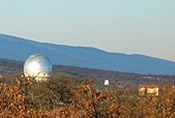|

BIRA-IASB Stations
In the framework of the NDACC network
(Network for the Detection of Atmospheric Composition Change) or in the context of specific projects,
BIRA-IASB measures at the following stations :
Bujumbura, Burundi
|
In the frame of the AGACC-2 project (Advanced exploitation of Ground-based measurements Atmospheric Chemistry and Climate applications), a MAXDOAS instrument has been installed at the top of the Department of physics of the University of Burundi.
This instrument, combined with a CIMEL sun photometer, measure aerosol and several ozone precursors like glyoxal (CHOCHO), formaldehyde (HCHO), and
tropospheric nitrogen dioxide (NO2). These measurements contribute to a better study of African emissions as well as the transport of biomass burning plumes from Africa to the Indian Ocean. More...
|

|
Harestua, Norway
|
The « Solobservatoriet of Harestua » is a small but well-known solar observatory near Harestua, located about 40 km nortwards Oslo, Norway.
Harestua is part of the NDACC network as a complementary station. BIRA-IASB operates a fully automated zenith-sky DOAS instruments since 1998 and provides the NDACC data base with stratospheric NO2, O3, BrO and OClO data. The station is also equipped with a high-resolution FTIR spectrometer operated by the Department of Radio and Space Science, Chalmers University of Technology, Gothenburg.
More...
|

|
Jungfraujoch, Switzerland
|
The International Scientific Station of the Jungfraujoch (ISSJ) is a very nice observatory located in the Swiss Alps (46°N, 3570 m). It is part of the NDACC network as one of the primary alpine station. Due to its privilegied position, the station is the base for a lot of scientific work in many varied research fields such as physiology, meteorology, glaciology, atmospheric research...
ISSJ participates to a large number of international scientific programmes including European and international satellite validation projects. In the frame of NDACC activities, BIRA-IASB operated a SAOZ instrument from June 1990 to July 2014 and has installed a two-channels MAXDOAS instrument in July 2010.
The station is also equipped with a high-resolution FTIR spectrometer operated jointly by BIRA-IASB and the Université de Liège (Belgium).
More...
|

|
Observatoire de Haute-Provence (OHP), France
|
OHP is also one of the primary alpine stations of the NDACC network.
Because OHP alternates between background and polluted conditions (essentially due to transport from polluted neighbourhoods), it is a very interesting location for measuring. Several institutes operate different instruments (LIDAR, SAOZ, Dobson, balloons...).
BIRA-IASB participated an important intercomparison campaign at OHP in 1996 and came back in 1998 with a innovative instrument optimized precisely for the detection of the BrO. Low resolution vertical profiles of BrO have been retrieved by applying a profiling technique to the ground-based MAXDOAS observations.
Moreover, data from the MAXDOAS instrument of OHP are currently used in the O3MSAF framework for the validation of the operational GOME-2A and GOME-2B NO2 product.
More...
|

|
Princess Elisabeth station, Antarctica
|
Belgium has a long history of Antarctic exploration and scientific activities, dating back to the first expeditions to Antarctica under the lead of Adrien de Gerlache in 1897. At the occasion of the International Polar Year 2007, the Belgian government decided to build a new scientific summer station in Antarctica. The new Antarctic base Princess Elisabeth was built during the Antarctic summers 2007/2008 and 2008/2009 and the first scientific activities started in January 2009.
BIRA-IASB operates a CIMEL sunphotometer at the Princess Elisabeth station since February 2009. In December 2015, in the frame of the AEROCLOUD project, a MAXDOAS system has been installed for atmospheric trace gases (NO2, O4, O3, ...) and aerosols profiles retrieval.
More...
|

|
Le Port, Reunion Island
|
Reunion island is part of the ground-based Network for the Detection of Atmospheric
Composition Change (NDACC). Ground-based Fourier transform infrared (FTIR) solar absorption measurements are performed by BIRA-IASB at the University of Saint-Denis since 2002 and at the new observatory located at Maido
mount (2200m a.s.l.) since 2012. To complete these measurements, BIRA-IASB operates also MAXDOAS measurements since April 2016 (after a first installation from July 2004 to July 2005).
More...
|

|
Uccle (Brussels), Belgium
|
In the framework of the AGACC-2 project, a mini-MAXDOAS instrument has been installed at Uccle since May 2011,
on the roof of the IRM-KMI building. On the site, Brewer and CIMEL instruments are also operated continuously. The mini-MAXDOAS is a commercial system from Hoffmann Messtechnik GmbH,
consisting of an Ocean Optics spectrograph, diffraction grating, and a CCD detector. The whole instrument
is contained in a compact metal box (13x19x14 cm3) mounted on a stepper motor,
allowing the change in viewing elevation angle.
More...
|

|
Xianghe, China
|
Due to rapid urbanization and industrial development, air pollution has become a major environmental issue in China. Within the context of the Sino-Belgian R&D cooperation, BIRA-IASB has concluded an agreement for joint scientific research activities with the Institute of Atmospheric Physics of the Chinese Academy of Sciences (IAP/CAS). This collaboration materialized with the setting up and operation of an advanced system for the remote sensing monitoring of air quality in Beijing based the MAXDOAS technique.
BIRA-IASB has operated a MAXDOAS instrument on the roof of the IAP/CAS building in 1998 for one year. This period covered the Olympic games. Then, in February 2010, the MAXDOAS has been definitely installed at the top of the LAGEO Institute in Xianghe (39.75°N, 117°E), located about 60 km east of Beijing.
More...
|

|
|











